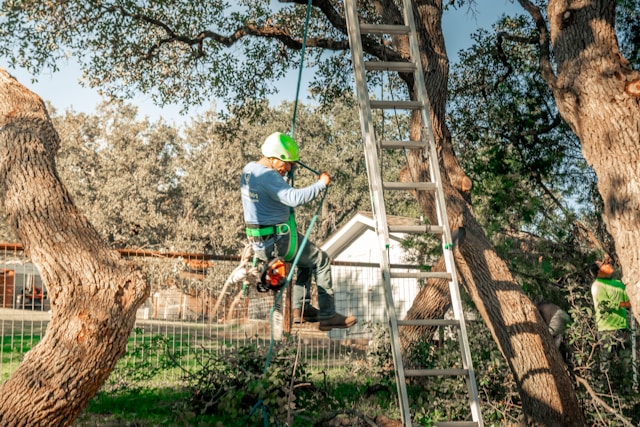St. Petersburg Tree Service Tips: The Best Fall Fertilizing Practices for Healthy Canopies
September 15, 2025|
For ideal fall tree service in St. Petersburg, FL, you’ll want to focus on slow-release formulations applied between September and November. Start by testing your sandy soil and measuring your tree’s dripline diameter to calculate the treatment area. Apply a phosphorus and potassium-rich fertilizer in an even ring pattern around the dripline, then water thoroughly. Understanding proper timing and local soil challenges will help you maximize your tree’s health before winter dormancy.  Why Fall Fertilization Matters for Trees in St. Petersburg, FLFall fertilization in St. Petersburg provides critical support for your trees’ long-term health. The best fertilizer for Florida trees during this season focuses on phosphorus and potassium, which strengthen root systems before winter. Your coastal soil fertilization needs special attention due to sandy soil conditions that quickly leach nutrients. Before applying any products, soil testing for trees helps determine specific nutrient deficiencies. When fertilizing sandy soil, use slow-release formulations and apply them around the dripline fertilization zone—the area beneath your tree’s outermost branches. This targeted approach guarantees nutrients reach active root zones efficiently, promoting robust spring growth. Understanding Local Soil and Climate ChallengesSince St. Pete soil conditions present unique challenges for tree care, you’ll need to understand how our local sandy soil affects fertilization. Your trees face rapid nutrient leaching due to the quick-draining nature of our soil, making timing and product selection essential. Our sandy base doesn’t hold nutrients well, requiring carefully chosen slow-release fertilizers to maintain steady nutrient levels. You’ll also need to ponder our climate’s impact – while we don’t face harsh winters, our soil’s characteristics mean nutrients can wash away quickly during heavy rains. Understanding these local factors will help you make informed fertilization decisions. Pre-Fertilizing Steps for HomeownersTaking the proper preparatory steps before applying fertilizer will maximize its effectiveness in St. Petersburg’s sandy soils. Before you begin, conduct a soil test to determine existing nutrient levels and pH balance. These tree service tips guarantee targeted application: measure your tree’s dripline diameter, calculate the square footage of the treatment area, and inspect for signs of disease or stress that might affect fertilizer uptake. Remove any thick grass or debris around the base, and check weather forecasts – avoid applying before heavy rains that could wash away nutrients. Mark irrigation heads and utility lines to prevent damage during application. Choosing the Right Fertilizer for Fall Tree HealthWhen selecting fertilizer for St. Petersburg trees this fall, prioritize slow-release formulations high in phosphorus and potassium. These nutrients support root development and winter hardiness while avoiding excessive nitrogen that could trigger vulnerable new growth. For ideal fall lawn care St. Pete specialists recommend choosing fertilizers with NPK ratios like 5-10-10 or 3-15-15 to match our sandy soil conditions. Your fertilizer should account for rapid drainage common in local soils. Look for controlled-release granules that won’t quickly leach away. Consider micronutrient content, especially iron and manganese, which are often deficient in Florida’s alkaline soils. Application Best Practices for St. Petersburg LawnsProper application techniques make your fall fertilizer investment count in St. Petersburg’s sandy soils. When you’re ready to fertilize, start at your tree’s dripline – that’s where the most active roots grow. Spread the fertilizer in a ring pattern, avoiding direct contact with the trunk. For best results, use a slow-release formula and apply it evenly across the root zone. If you’re unsure about proper application rates, contact a tree service St. Petersburg, FL expert for guidance. Test your soil first to determine exact nutrient needs. Remember to water thoroughly after application to help nutrients reach the root system. Mistakes to Avoid When Fertilizing Trees in FallEven experienced gardeners can make critical mistakes when fertilizing trees during St. Petersburg’s fall season. Don’t over-apply nitrogen-heavy fertilizers, which stimulate vulnerable new growth before winter. You’ll want to avoid spreading fertilizer directly against the trunk or beyond the dripline where roots can’t access nutrients. Never guess at application rates – conduct proper soil testing first. Applying fertilizer too late in the season or using quick-release formulations in our sandy soils leads to nutrient waste and potential groundwater contamination. Remember to water thoroughly after application, but don’t oversaturate, as this can leach away essential nutrients. What Results to Expect From Proper Fall FertilizationFollowing careful fall fertilization practices yields measurable benefits for St. Petersburg trees. You’ll notice enhanced root development during winter dormancy, as phosphorus and potassium support underground growth. By spring, you can expect stronger branch structure and more vibrant leaf emergence. Your trees will show improved drought tolerance due to deeper root systems, while maintaining better resistance against local pests and diseases. Proper fall fertilization also results in denser canopies, reduced deadwood, and more efficient nutrient uptake through the sandy soil. You’ll see sustained growth benefits throughout the following growing season. Work With Local Experts in Tree FertilizationWhen tackling tree fertilization in St. Petersburg, it’s indispensable to consult certified arborists who understand local soil conditions and species-specific needs. These professionals can perform detailed soil analyses, identify nutrient deficiencies, and recommend appropriate fertilizer formulations for your trees. Local experts have experience with Florida’s sandy soils and can precisely calculate application rates based on trunk diameter and canopy size. They’ll guarantee proper placement around the dripline, avoiding common mistakes like over-fertilization or incorrect timing. Professional arborists also monitor tree health year-round, adjusting fertilization strategies as needed for ideal results in our unique climate. |
|